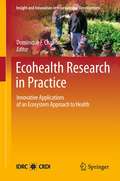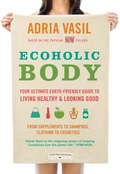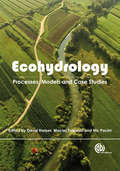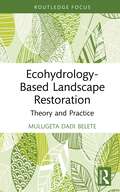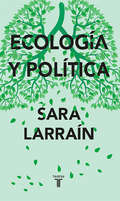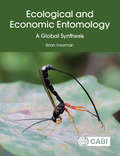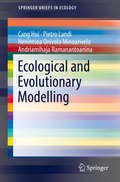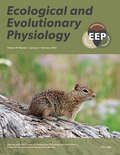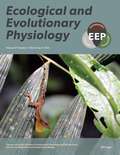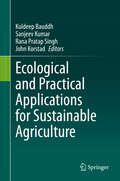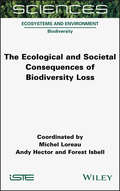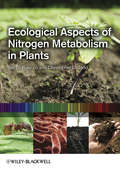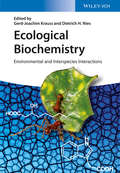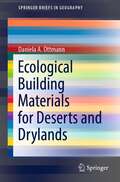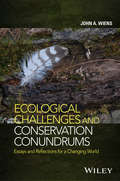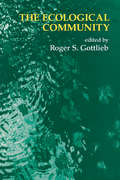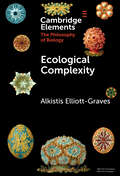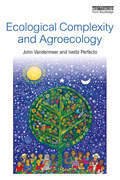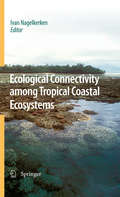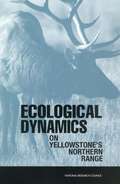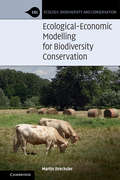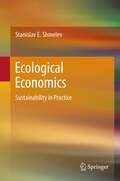- Table View
- List View
Ecohealth Research in Practice
by Dominique F. CharronThis book is about doing innovative research to achieve sustainable and equitable change in people's health and well-being through improved interactions with the environment. It presents experiences from the field of ecosystem approaches to health (or ecohealth research) and some insights and lessons learned. It builds on previous literature, notably Forget (1997), Forget and Lebel (2001), Lebel (2003), and Waltner-Toews et al. (2008). Through case-studies and other contributions by researchers supported by Canada's International Development Research Centre (IDRC), the book presents evidence of real changes in conditions of people, their health, and the ecosystems that support them. These changes were derived from applications of an ecosystem approach to health in developing regions of the world. The book also illustrates the resulting body of applied, participatory, and action research that improved health and environmental management in developing countries and, in many cases, influenced policies and practices.
Ecoholic Body: Your Ultimate Earth-friendly Guide to Living Healthy and Looking Good
by Adria VasilAdria Vasil, Canada's straight-shooting green living expert, is back, and this time it's personal . . . care, that is. Her latest eco bible delivers the lowdown on virtually every product that comes into contact with our bodies. From the pollutants clogging your sinus meds all the way to the outlaw toxins leaching from your sandals, ECOHOLIC BODY has you covered, head to toe. Never shy to blow the whistle, Adria calls out supplement and shampoo makers that exaggerate their green cred. This witty, indispensable guide will arm you with the knowledge you need to keep you and your family healthy, happy and green, all while detoxing the planet. Look your best- "Mean 15" ingredients to avoid- Skin care reviews for moisturizers, sunscreen, anti-aging and acne- Fresh ways to fight funk from bad breath to B.O.- Toxin-free hair care that works- The lowdown on mineral makeup, natural cosmetics, tattoos and more Feel your best- Nature's best remedies and superfoods that are good for the planet and your body- Greening your health care- Pollution-triggered health problems- Ecoholic weight loss plan- Greener birth control, local sex toys and more Dress your best- All the latest eco fashions, including activewear, maternity clothes, lingerie, menswear, footwear, jewellery, wedding dresses and more Give your kids nature's best- Toxin-free bum balms, shampoos, bubble bath, oils and powders- Green diaper reviews- The scoop on kids' PJs, clothes, charms And more- Exhaustive testing guides for everything from natural deodorant to herbal shampoos- Made-in-Canada products and services- Coast-to-coast store directory- DIY recipes for homemade body care- Money-saving tips in every chapterose hands touched? She rehearsed the questions she wondered if she would ever be able to ask. Why do you do it? Is it necessary to your poetry? Why did you choose this job? Or did it choose you?-- from The Murder RoomFrom the Hardcover edition.
Ecohydrology: An Approach to the Sustainable Management of Water Resources
by Maciej Zalewski Nic Pacini David HarperEcohydrology is an emerging new sub-discipline which links elements of ecology with hydrology at all points in the water cycle, ranging in scale from water-plant physiological relationships to whole catchment water-ecosystem processes. This book pays most attention to the larger scales of ecohydrology, emphasizing the use of this tool in striving towards the goal of sustainable water management. Authors from Eastern and Western Europe, America, Australia and South Africa give a broad global context.
Ecohydrology-Based Landscape Restoration: Theory and Practice (Routledge Focus on Environment and Sustainability)
by Mulugeta Dadi BeleteThis book provides an introduction to a fairly new approach to natural resources management practice entitled ecohydrology-based landscape restoration. Ecohydrology-based landscape restoration integrates landscape restoration practices with ecohydrology science and principles in order to help address the limitations of current management practices in developing countries. Focusing on both the theory and practice of implementing new management practices, the book includes conceptual designs and practical demonstrations for a variety of sites, including hillsides, farmlands, gullies, riparian buffers and wetlands, while also drawing on field research conducted in Ethiopia. The book puts forward principles for improving current practices, which include the better integration of hydrological and ecological concerns, the greater involvement of local communities, the adoption of indigenous practices, the establishment of green and semi-grey infrastructure as an ecohydrological systemic solution and the necessity of taking an adaptive approach to managing landscapes. This book will be of great interest to students and scholars of water resource management, ecohydrology and landscape restoration as well as professionals involved in the restoration of landscapes in developing countries.
Ecología y política
by Sara LarraínUna breve y útil exposición de la historia y las principales corrientes ecologistas, desde Platón a nuestros días El cambio climático ha sido generado por nuestra forma de habitar la Tierra: por nuestros patrones de producción y consumo basados en combustibles fósiles —carbón, petróleo y gas—, por la doctrina económica dominante y globalizada —sobre todo por sus modelos de negocios—, y por el extractivismo desatado sobre todos los recursos naturales y ecosistemas del planeta. La emergencia climática, cuya más drástica amenaza es el calentamiento global y el fin de las aguas y los bosques como hoy los conocemos, ya está afectando gravemente a todos los pueblos y comunidades que dependen en forma directa de la naturaleza y se aproxima a devastar las formas de vida urbanas. Ante este escenario, la destacada ambientalista chilena Sara Larraín, discípula de Gastón Soublette, quien durante décadas se ha dedicado a enseñar los fundamentos filosóficos del pensamiento ecologista, ofrece un conciso y fundamental ensayo de divulgación filosófica. La actualidad del problema, ante el catastrófico escenario global, supone una oportunidad única para aquellos que, alarmados ante el cambio climático, desean introducirse con urgencia en las raíces del pensamiento medioambiental.
Ecological and Economic Entomology: A Global Synthesis
by Brian FreemanEcological and Economic Entomology is a comprehensive advanced text covering all aspects of the role of insects in natural ecosystems and their impacts on human activity. The book is divided into two sections. The first section begins with an outline of the structure, classification and importance of insects, followed by the geographical aspects of plant distribution and the complex defences plants marshal against herbivorous insects. Insect pests affecting plant roots, stem, leaf, and reproductive systems are covered in a comprehensive review. This section also covers insects that are important in medical and veterinary science, paying particular attention to those that transmit pathogens. The section concludes with the beneficial aspects of insects, especially their use in biological control, but also as soil formers and their importance in forensic science. Autecology (or single-species ecology) and its application to pest management is the focus of the second section of the book. Firstly, some general aspects of autecology are examined, including species abundance, competition and speciation, and relevant genetics. The classic general theories of insect population dynamics are reviewed, followed by chapters on life tables, time series analysis and mathematical models in insect populations. The final chapter reviews the application of autecology to the insect pests of forests, farms and orchards and to the control of insect vectors of diseases of humans and livestock. Particular attention is paid to environmentally friendly methods of pest management and the application of Integrated Pest Management (IPM) techniques. This volume is essential reading for professional entomologists and advanced students of agricultural, medical and veterinary entomology, insect ecology and conservation.
Ecological and Evolutionary Modelling (SpringerBriefs in Ecology)
by Cang Hui Pietro Landi Henintsoa Onivola Minoarivelo Andriamihaja RamanantoaninaEcology studies biodiversity in its variety and complexity. It describes how species distribute and perform in response to environmental changes. Ecological processes and structures are highly complex and adaptive. In order to quantify emerging ecological patterns and investigate their hidden mechanisms, we need to rely on the simplicity of mathematical language. Ecological patterns are emerging structures observed in populations, communities and ecosystems. Elucidating drivers behind ecological patterns can greatly improve our knowledge of how ecosystems assemble, function and respond to change and perturbation. Mathematical ecology has, thus, become an important interdisciplinary research field that can provide answers to complex global issues, such as climate change and biological invasions.The aim of this book is to (i) introduce key concepts in ecology and evolution, (ii) explain classic and recent important mathematical models for investigating ecological and evolutionary dynamics, and (iii) provide real examples in ecology/biology/environmental sciences that have used these models to address relevant issues. Readers are exposed to the key concepts, frameworks, and terminology in the studies of ecology and evolution, which will enable them to ask the correct and relevant research questions, and frame the questions using appropriate mathematical models.
Ecological and Evolutionary Physiology, volume 97 number 1 (January/February 2024)
by Ecological and Evolutionary PhysiologyThis is volume 97 issue 1 of Ecological and Evolutionary Physiology. Ecological and Evolutionary Physiology primarily publishes original research in physiological ecology, ecophysiology, comparative physiology, and evolutionary physiology. Studies at all levels of biological organization from the molecular to the whole organism are welcome, and work that integrates across levels of organization is particularly encouraged. Studies that focus on behavior or morphology are welcome, so long as they include ties to physiology or biochemistry, in addition to having an ecological or evolutionary context. Subdisciplines of interest include nutrition and digestion, salt and water balance, epithelial and membrane transport, gas exchange and transport, acid-base balance, temperature adaptation, energetics, structure and function of macromolecules, chemical coordination and signal transduction, nitrogen metabolism and excretion, locomotion and muscle function, biomechanics, circulation, behavioral, comparative and mechanistic endocrinology, sensory physiology, neural coordination, and ecotoxicology ecoimmunology.
Ecological and Evolutionary Physiology, volume 97 number 2 (March/April 2024)
by Ecological and Evolutionary PhysiologyThis is volume 97 issue 2 of Ecological and Evolutionary Physiology. Ecological and Evolutionary Physiology primarily publishes original research in physiological ecology, ecophysiology, comparative physiology, and evolutionary physiology. Studies at all levels of biological organization from the molecular to the whole organism are welcome, and work that integrates across levels of organization is particularly encouraged. Studies that focus on behavior or morphology are welcome, so long as they include ties to physiology or biochemistry, in addition to having an ecological or evolutionary context. Subdisciplines of interest include nutrition and digestion, salt and water balance, epithelial and membrane transport, gas exchange and transport, acid-base balance, temperature adaptation, energetics, structure and function of macromolecules, chemical coordination and signal transduction, nitrogen metabolism and excretion, locomotion and muscle function, biomechanics, circulation, behavioral, comparative and mechanistic endocrinology, sensory physiology, neural coordination, and ecotoxicology ecoimmunology.
Ecological and Practical Applications for Sustainable Agriculture
by Kuldeep Bauddh Sanjeev Kumar Rana Pratap Singh John KorstadRampant industrialization, urbanization, and population growth have resulted in increased global environmental contamination. The productivity of agricultural soil is drastically deteriorated and requires a high dose of fertilizers to cultivate crops. To ensure food security, farmers are compelled to apply excess chemical fertilizers and insecticides that contaminate soil, air, and water. Heavy loads of chemical fertilizers not only degrade the quality of agricultural land but also pollute water and air. Use of chemical fertilizers also accelerate the release of greenhouse gases like nitrous oxide and methane along with nutrient runoff from the watershed in to lower elevation rivers and lakes, resulting in cultural eutrophication.Farming practices globally in developed, developing, and under-developing countries should utilize and promote sustainable methods through viable combined environmental, social, and economic means that improve rather than harm future generations. This can include use of non-synthetic fertilizers like compost, vermicompost, slow-release fertilizers, farmyard manures, crop rotations that include nitrogen-fixing legumes. Organic fertilizers like compost and vermicompost improve soil properties like texture, porosity, water-holding capacity, organic matter, as well as nutrient availability. The purpose of this book is to document the available alternatives of synthetic fertilizers, their mode of action, efficiency, preparation methodology, practical suggestions for sustainable practices, and needed research focus. The book will cover major disciplines like plant science, environmental science, agricultural science, agricultural biotechnology and microbiology, horticulture, soil science, atmospheric science, agro-forestry, agronomy, and ecology. This book is helpful for farmers, scientists, industrialists, research scholars, masters and graduate students, non-governmental organizations, financial advisers, and policy makers.
The Ecological and Societal Consequences of Biodiversity Loss
by Michel Loreau Andy Hector Forest IsbellThe idea that changes in biodiversity can impact how ecosystems function has, over the last quarter century, gone from being a controversial notion to an accepted part of science and policy. As the field matures, it is high time to review progress, explore the links between this new research area and fundamental ecological concepts, and look ahead to the implementation of this knowledge.This book is designed to both provide an up-to-date overview of research in the area and to serve as a useful textbook for those studying the relationship between biodiversity and the functioning, stability and services of ecosystems. The Ecological and Societal Consequences of Biodiversity Loss is aimed at a wide audience of upper undergraduate students, postgraduate students, and academic and research staff.
Ecological Aspects of Nitrogen Metabolism in Plants
by Joe C. Polacco Christopher D. ToddEcological Aspects of Nitrogen Acquisition covers how plants compete for nitrogen in complex ecological communities and the associations plants recruit with other organisms, ranging from soil microbes to arthropods. The book is divided into four sections, each addressing an important set of relationships of plants with the environment and how this impacts the plant’s ability to compete successfully for nitrogen, often the most growth-limiting nutrient. Ecological Aspects of Nitrogen Acquisition provides thorough coverage of this important topic, and is a vitally important resource for plant scientists, agronomists, and ecologists.
Ecological Biochemistry
by Dietrich H. Nies Gerd-Joachim KraussThe first stand-alone textbook for at least ten years on this increasingly hot topic in times of global climate change and sustainability in ecosystems.Ecological biochemistry refers to the interaction of organisms with their abiotic environment and other organisms by chemical means. Biotic and abiotic factors determine the biochemical flexibility of organisms, which otherwise easily adapt to environmental changes by altering their metabolism. Sessile plants, in particular, have evolved intricate biochemical response mechanisms to fit into a changing environment. This book covers the chemistry behind these interactions, bottom up from the atomic to the system's level.An introductory part explains the physico-chemical basis and biochemical roots of living cells, leading to secondary metabolites as crucial bridges between organisms and the respective ecosystem. The focus then shifts to the biochemical interactions of plants, fungi and bacteria within terrestrial and aquatic ecosystems with the aim of linking biochemical insights to ecological research, also in human-influenced habitats.A section is devoted to methodology, which allows network-based analyses of molecular processes underlying systems phenomena.A companion website offering an extended version of the introductory chapter on Basic Biochemical Roots is available at http://www.wiley.com/go/Krauss/Nies/EcologicalBiochemistry
Ecological Building Materials for Deserts and Drylands (SpringerBriefs in Geography)
by Daniela A. OttmannThis book examines prospective climate adaptive building materials in desert and drylands in the context of climate change, desertification, urbanisation demands, and the consequent sustainable urban development challenges. This preliminary collection of ecological materials covers the characterisation of biotic and abiotic resources for materials, their specifications and benefits for adequate bio-climatic design and construction. Particular emphasis is given to ecological composite materials for advances in desert architecture. Based on the initial collection, the book culminates with potentials for new ecological building materials. The "eComposite Combinator" matrix offers potential research recipes and encourages the reader to conduct further climate-matters related research.
Ecological Census Techniques
by William J. SutherlandVirtually any exercise in ecology will require some knowledge of the techniques for carrying out a census of population numbers. This practical text outlines clearly, with worked examples, the main techniques used by field ecologists to enumerate plants and animals. Each taxonomic group is treated separately, with detailed descriptions of appropriate census methods; their advantages, disadvantages and biases. Techniques for measuring a wide range of environmental variables are also included. The final chapter lists the 20 most common censusing sins. Concise yet comprehensive, this book provides a unique overview of the most important methods for those working on field studies in population and behavioural ecology and conservation biology at all levels, from the beginner to the practising professional.
Ecological Challenges and Conservation Conundrums
by John A. Wiensy, reading the essays together fosters a broader perspective on the issues. Readers will be able find out how the ecological systems they strive to conserve are affected by various forces of change, and how this affects the way they should approach the issues. Collectively, the essays encompass many of the central issues that are shaping ecology and conservation as the world changes. The essays are arranged by topic and each includes a short introduction that updates the context and explains why the essay was written. Six brand new essays have been written specifically for this volume to fill the in the area. In all, this book may help to prompt a shift in how scientists, managers, and the public think about these key issues. Brief TOC: Concluding comments: are bird communities real?; On skepticism and criticism in ornithology; Word processing versus writing; The place of long-term studies in ornithology; Ecology 2000: An essay on future directions in ecology; Fat times, lean times and competition among predators; Scientific responsibility and responsible ecology; Landscape ecology: the science and the action; Found! The survivor in the swamps; What's so new about ecosystem services?; Will land-use change erode our conservation gains?; The dangers of black-and-white conservation; The demise of wildness?; Uncertainty and the relevance of ecology; Polar bears, golden toads, and conservation futures; The eclipse of history?; "It was the best of times, it was the worst of times..."; Is 'monitoring' a dirty word?; Moving outside the box; Tipping points in the balance of nature; Stewart Udall and the future of conservation; Oil, oil, everywhere; Being green isn't easy; From our southern correspondent(s); Shooting at a moving target; Black swans and outliers; Taking risks with the environment; Wildlife, people, and water: Who wins?
Ecological Climatology
by Gordon BonanThe third edition of Gordon Bonan's comprehensive textbook introduces an interdisciplinary framework to understand the interaction between terrestrial ecosystems and climate change. Ideal for advanced undergraduate and graduate students studying ecology, environmental science, atmospheric science, and geography, it reviews basic meteorological, hydrological, and ecological concepts to examine the physical, chemical, and biological processes by which terrestrial ecosystems affect and are affected by climate. This new edition has been thoroughly updated with new science and references. The scope has been expanded beyond its initial focus on energy, water, and carbon to include reactive gases and aerosols in the atmosphere. The new edition emphasizes the Earth as a system, recognizing interconnections among the planet's physical, chemical, biological, and socioeconomic components, and emphasizing global environmental sustainability. Each chapter contains chapter summaries and review questions, and with over 400 illustrations, including many in color, this textbook will once again be an essential student guide.
Ecological Climatology
by Gordon B. BonanThis book introduces an interdisciplinary framework to understand the interaction between terrestrial ecosystems and climate change. It reviews basic meteorological, hydrological and ecological concepts to examine the physical, chemical and biological processes by which terrestrial ecosystems affect and are affected by climate. The textbook is written for advanced undergraduate and graduate students studying ecology, environmental science, atmospheric science and geography. The central argument is that terrestrial ecosystems become important determinants of climate through their cycling of energy, water, chemical elements and trace gases. This coupling between climate and vegetation is explored at spatial scales from plant cells to global vegetation geography and at timescales of near instantaneous to millennia. The text also considers how human alterations to land become important for climate change. This restructured edition, with updated science and references, chapter summaries and review questions, and over 400 illustrations, including many in color, serves as an essential student guide.
The Ecological Community: Environmental Challenges For Philosophy, Politics And Morality
by Roger S. GottliebFirst Published in 1997. Routledge is an imprint of Taylor & Francis, an informa company.
Ecological Complexity (Elements in the Philosophy of Biology)
by Alkistis Elliott-GravesComplexity has received substantial attention from scientists and philosophers alike. There are numerous, often conflicting, accounts of how complexity should be defined and how it should be measured. Much less attention has been paid to the epistemic implications of complexity, especially in Ecology. How does the complex nature of ecological systems affect ecologists' ability to study them? This Element argues that ecological systems are complex in a rather special way: they are causally heterogeneous. Not only are they made up of many interacting parts, but their behaviour is variable across space or time. Causal heterogeneity is responsible for many of the epistemic difficulties that ecologists face, especially when making generalisations and predictions. Luckily, ecologists have the tools to overcome these difficulties, though these tools have historically been considered suspect by philosophers of science. The author presents an updated philosophical account with an optimistic outlook of the methods and status of ecological research.
Ecological Complexity and Agroecology
by John Vandermeer Ivette PerfectoThis text reflects the immense current growth in interest in agroecology and changing approaches to it. While it is acknowledged that the science of ecology should be the basis of agroecological planning, many analysts have out-of-date ideas about contemporary ecology. Ecology has come a long way since the old days of "the balance of nature" and other romantic notions of how ecological systems function. In this context, the new science of complexity has become extremely important in the modern science of ecology. The problem is that it tends to be too mathematical and technical and thus off-putting for the average student of agroecology, especially those new to the subject. Therefore this book seeks to present ideas about ecological complexity with a minimum of formal mathematics. The book’s organization consists of an introductory chapter, and a second chapter providing some of the background to basic ecological topics as they are relevant to agroecosystrems (e.g., soil biology and pest control). The core of the book consists of seven chapters on key intersecting themes of ecological complexity, including issues such as spatial patterns, network theory and tipping points, illustrated by examples from agroecology and agricultural systems from around the world.
Ecological Connectivity among Tropical Coastal Ecosystems
by Ivan NagelkerkenMangrove forests, seagrass beds, and coral reefs are circumtropical ecosystems that are highly productive, and provide many important biological functions and economic services. These ecosystems cover large surface areas in the shallow tropical coastal seascape but have suffered from serious human degradation, especially in the last few decades. Part of their diversity, productivity, and functioning seems to be based on their juxtaposition. Especially in the last decade significant advances have been made on new insights into their ecological connectivity. This authoritative book provides a first-time comprehensive review of the major ecological interactions across tropical marine ecosystems that result from the mutual exchange of nutrients, organic matter, fish, and crustaceans. A group of leading authors from around the world reviews the patterns and underlying mechanisms of important biogeochemical and biological linkages among tropical coastal ecosystems in 15 chapters. Included are chapters that review cutting-edge tools to study and quantify these linkages, the importance of such linkages for fisheries, and how tropical ecosystems should be conserved and managed for sustainable use by future generations. The book uses examples from all over the world and provides an up-to-date review of the latest published literature. This book is a 'must read' for professionals working on the conservation, management, and ecology of mangrove, seagrass and coral reef ecosystems.
Ecological Dynamics On Yellowstone's Northern Range
by Committee on Ungulate Management in Yellowstone National ParkEcological Dynamics on Yellowstone’s Northern Range discusses the complex management challenges in Yellowstone National Park. Controversy over the National Park Service’s approach of "natural regulation" has heightened in recent years because of changes in vegetation and other ecosystem components in Yellowstone's northern range. Natural regulation minimizes human impacts, including management intervention by the National Park Service, on the park ecosystem. Many have attributed these changes to increased size of elk and other ungulate herds.This report examines the evidence that increased ungulate populations are responsible for the changes in vegetation and that the changes represent a major and serious change in the Yellowstone ecosystem. According to the authors, any human intervention to protect species such as the aspen and those that depend on them should be prudently localized rather than ecosystem-wide. An ecosystem--wide approach, such as reducing ungulate populations, could be more disruptive. The report concludes that although dramatic ecological change does not appear to be imminent, approaches to dealing with potential human--caused changes in the ecosystem, including those related to climate change, should be considered now. The need for research and public education is also compelling.
Ecological-Economic Modelling for Biodiversity Conservation (Ecology, Biodiversity and Conservation)
by Martin DrechslerEcologists and economists both use models to help develop strategies for biodiversity management. The practical use of disciplinary models, however, can be limited because ecological models tend not to address the socioeconomic dimension of biodiversity management, whereas economic models tend to neglect the ecological dimension. Given these shortcomings of disciplinary models, there is a necessity to combine ecological and economic knowledge into ecological-economic models. Gradually guiding the reader into the field of ecological-economic modelling by introducing mathematical models and their role in general, this book provides an overview on ecological and economic modelling approaches relevant for research in the field of biodiversity conservation. It discusses the advantages of and challenges associated with ecological-economic modelling, together with an overview of useful ways of integration. Although being a book about mathematical modelling, ecological and economic concepts play an equally important role, making it accessible for readers from very different disciplinary backgrounds.
Ecological Economics: Sustainability in Practice
by Stanislav E. ShmelevIn a concise and crisp manner, this book presents the state of the art in ecological economics, an interdisciplinary field focused on the analysis of sustainability of global, national and regional economic systems. An elegant guide, the book offers a range of cutting edge methods used in sustainability research including multicriteria decision aid (MCDA), input-output analysis, and life cycle analysis. This book is packed with references for students with some background in economics, environmental science or mathematics who aim to develop the analytical skills required for redirecting our development path towards sustainability in government, international organisations, academia, non-profit sector and business. As such, the book is primarily aimed at MSc and first year PhD students reading for degrees in Environmental Change and Management, Ecological Economics, Environmental Management, Philosophy, Politics and Economics, and those taking part in similar programmes. The book strives to develop the idea that a significant adjustment of the current economic theories is required, an idea supported by the emerged world economic crisis, the climatic and biodiversity crisis the world is currently facing and the enormously slow progress that has been made in the field of reorientation of the global economy towards sustainability. The practical case studies provided focus on the most pressing topics of today, and the book adopts a positive approach for problem solving and strategic development, which is aimed at educating the future decision makers and business leaders.
